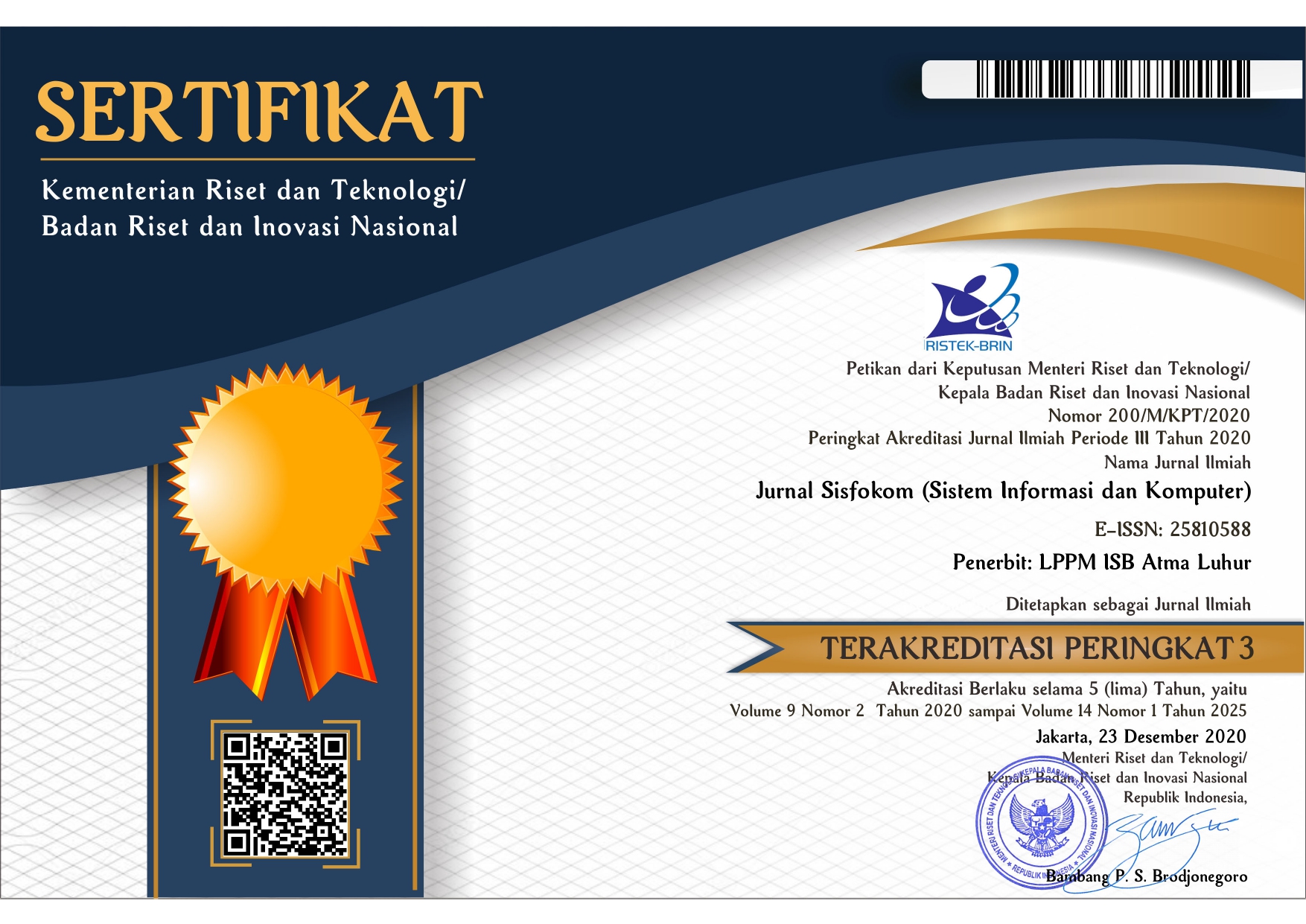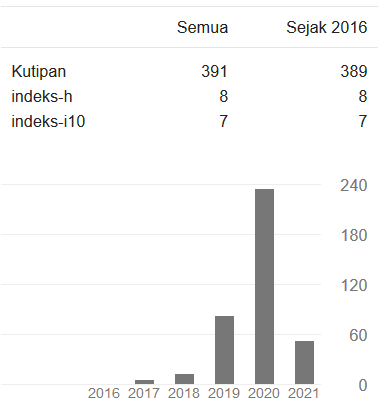Hyperparameter Tuning of EfficientNet Method for Optimization of Malaria Detection System Based on Red Blood Cell Image
DOI:
https://doi.org/10.32736/sisfokom.v13i3.2257Keywords:
Malaria Detection, Red Blood Cell Image, EfficientNet, Hyperparameter Tuning, Model PerformanceAbstract
Nowadays, malaria has become an infectious disease with a high mortality rate. One way to detect malaria is through microscopic examination of blood preparations, which is done by experts and often takes a long time. With the development of deep learning technology, the observation of blood cell images infected with malaria can be more easily done. Therefore, this study proposes a red blood cell image-based malaria detection system using the EfficientNet method with hyperparameter tuning. There are three parameters which are learning rate, activation function, and optimiser. The learning rate used is 0.01 and 0.001, while the activation functions used are ReLU and Tanh. In addition, the optimisers used include Adam, SGD, and RMSProp. In the implementation, the cell image dataset from the NIH repository was pre-processed such as resizing, rotating, filtering, and data augmentation. Then the data is trained and tested on several EfficientNet models (B0, B1, B3, B5, and B7) and their performance values are compared. Based on the test results, EfficientNet-B5 and B7 models showed the best performance compared to other EfficientNet models. The most optimal system test results are when the EfficientNet B5 model is used with a learning rate of 0.001, ReLU activation function, and Adam optimiser, with values of 97.69% (accuracy), 98.36% (precision), and 97.03% (recall). This research has proven that proper model selection and hyperparameter tuning can maximise the performance of cell image-based malaria detection system. The development of this EfficientNet-based diagnostic method is more sensitive and specific in malaria detection using RBCs.References
P. Venkatesan, “The 2023 WHO World malaria report,” The Lancet Microbe, vol. 5, no. 3, Jan. 2024, doi: https://doi.org/10.1016/s2666-5247(24)00016-8.
C. Marston et al., “Developing the Role of Earth Observation in Spatio-Temporal Mosquito Modelling to Identify Malaria Hot-Spots,” Remote Sensing, vol. 15, no. 1, pp. 43–43, Dec. 2022, doi: https://doi.org/10.3390/rs15010043.
H. Sutanto, “Combating Malaria with Vaccines: Insights from the One Health Framework,” Deleted Journal, vol. 69, no. 3, pp. 153–166, Jul. 2024, doi: https://doi.org/10.3390/amh69030015.
F. Grignaffini, P. Simeoni, A. Alisi, and F. Frezza, “Computer-Aided Diagnosis Systems for Automatic Malaria Parasite Detection and Classification: A Systematic Review,” Electronics, vol. 13, no. 16, pp. 3174–3174, Aug. 2024, doi: https://doi.org/10.3390/electronics13163174.
T. Song, Y. Wang, Y. Li, and G. Fan, “A Mathematical Analysis of Competitive Dynamics and Aggressive Treatment in the Evolution of Drug Resistance in Malaria Parasites,” Mathematics, vol. 12, no. 10, pp. 1595–1595, May 2024, doi: https://doi.org/10.3390/math12101595.
A. Alsulimani et al., “The Impact of Artificial Intelligence on Microbial Diagnosis,” Microorganisms, vol. 12, no. 6, pp. 1051–1051, May 2024, doi: https://doi.org/10.3390/microorganisms12061051.
D. A. Deo, E. H. Herningtyas, U. S. Intansari, T. M. Perdana, E. H. Murhandarwati, and M. H. N. E. Soesatyo, “Difference between Microscopic and PCR Examination Result for Malaria Diagnosis and Treatment Evaluation in Sumba Barat Daya, Indonesia,” Tropical Medicine and Infectious Disease, vol. 7, no. 8, pp. 153–153, Jul. 2022, doi: https://doi.org/10.3390/tropicalmed7080153.
D. G. Mordue et al., “Plasma Blood Levels of Tafenoquine following a Single Oral Dosage in BALBc Mice with Acute Babesia microti Infection That Resulted in Rapid Clearance of Microscopically Detectable Parasitemia,” Pathogens, vol. 12, no. 9, pp. 1113–1113, Aug. 2023, doi: https://doi.org/10.3390/pathogens12091113.
S. Abd El-Ghany, M. Elmogy, and A. El-Aziz, “Computer-Aided Diagnosis System for Blood Diseases Using EfficientNet-B3 Based on a Dynamic Learning Algorithm,” Diagnostics, vol. 13, no. 3, p. 404, Jan. 2023, doi: https://doi.org/10.3390/diagnostics13030404.
K. Hemachandran et al., “Performance Analysis of Deep Learning Algorithms in Diagnosis of Malaria Disease,” Diagnostics, vol. 13, no. 3, p. 534, Jan. 2023, doi: https://doi.org/10.3390/diagnostics13030534.
M. Mujahid et al., “Efficient deep learning-based approach for malaria detection using red blood cell smears,” Scientific Reports, vol. 14, no. 1, p. 13249, Jun. 2024, doi: https://doi.org/10.1038/s41598-024-63831-0.
S. Asiya, D. Aparna, N. Mahender, M. Raamizuddin, and P. Anoosha, “Malaria Parasite Detection Using Deep Neural Networks,” Lecture notes in networks and systems, pp. 309–321, Jan. 2024, doi: https://doi.org/10.1007/978-981-99-7817-5_23.
T. Jameela, K. Athotha, N. Singh, V. K. Gunjan, and S. Kahali, “Deep Learning and Transfer Learning for Malaria Detection,” Computational Intelligence and Neuroscience, vol. 2022, pp. 1–14, Jun. 2022, doi: https://doi.org/10.1155/2022/2221728.
Y. M. Kassim et al., “Clustering-Based Dual Deep Learning Architecture for Detecting Red Blood Cells in Malaria Diagnostic Smears,” IEEE Journal of Biomedical and Health Informatics, pp. 1–1, 2020, doi: https://doi.org/10.1109/jbhi.2020.3034863.
L. Alzubaidi, M. A. Fadhel, O. Al-Shamma, J. Zhang, and Y. Duan, “Deep Learning Models for Classification of Red Blood Cells in Microscopy Images to Aid in Sickle Cell Anemia Diagnosis,” Electronics, vol. 9, no. 3, p. 427, Mar. 2020, doi: https://doi.org/10.3390/electronics9030427.
K. Hoyos and W. Hoyos, “Supporting Malaria Diagnosis Using Deep Learning and Data Augmentation,” Diagnostics, vol. 14, no. 7, p. 690, Jan. 2024, doi: https://doi.org/10.3390/diagnostics14070690.
R. Nakasi, E. Mwebaze, and A. Zawedde, “Mobile-Aware Deep Learning Algorithms for Malaria Parasites and White Blood Cells Localization in Thick Blood Smears,” Algorithms, vol. 14, no. 1, p. 17, Jan. 2021, doi: https://doi.org/10.3390/a14010017.
K. M. F. Fuhad, J. F. Tuba, Md. R. A. Sarker, S. Momen, N. Mohammed, and T. Rahman, “Deep Learning Based Automatic Malaria Parasite Detection from Blood Smear and Its Smartphone Based Application,” Diagnostics, vol. 10, no. 5, May 2020, doi: https://doi.org/10.3390/diagnostics10050329.
Y. S. Cho and P. C. Hong, “Applying Machine Learning to Healthcare Operations Management: CNN-Based Model for Malaria Diagnosis,” Healthcare, vol. 11, no. 12, p. 1779, Jan. 2023, doi: https://doi.org/10.3390/healthcare11121779.
R. Ali, R. C. Hardie, B. N. Narayanan, and T. M. Kebede, “IMNets: Deep Learning Using an Incremental Modular Network Synthesis Approach for Medical Imaging Applications,” Applied Sciences, vol. 12, no. 11, p. 5500, May 2022, doi: https://doi.org/10.3390/app12115500.
Y. Dong and W. David Pan, “Image Classification in JPEG Compression Domain for Malaria Infection Detection,” Journal of Imaging, vol. 8, no. 5, pp. 129–129, May 2022, doi: https://doi.org/10.3390/jimaging8050129.
A. Kareem, H. Liu, and Vladan Velisavljevic, “A Privacy-Preserving Approach to Effectively Utilize Distributed Data for Malaria Image Detection,” Bioengineering, vol. 11, no. 4, pp. 340–340, Mar. 2024, doi: https://doi.org/10.3390/bioengineering11040340.
M. Semakula, F. Niragire, and C. Faes, “Spatio-Temporal Bayesian Models for Malaria Risk Using Survey and Health Facility Routine Data in Rwanda,” International journal of environmental research and public health/International journal of environmental research and public health, vol. 20, no. 5, pp. 4283–4283, Feb. 2023, doi: https://doi.org/10.3390/ijerph20054283.
S. Paul, S. Batra, K. Mohiuddin, Mohamed Nadhmi Miladi, D. Anand, and O. A. Nasr, “A Novel Ensemble Weight-Assisted Yolov5-Based Deep Learning Technique for the Localization and Detection of Malaria Parasites,” Electronics, vol. 11, no. 23, pp. 3999–3999, Dec. 2022, doi: https://doi.org/10.3390/electronics11233999.
S. Gamil, F. Zeng, Moath Alrifaey, M. Asim, and N. Ahmad, “An Efficient AdaBoost Algorithm for Enhancing Skin Cancer Detection and Classification,” Algorithms, vol. 17, no. 8, pp. 353–353, Aug. 2024, doi: https://doi.org/10.3390/a17080353.
I. Manole, A.-I. Butacu, R. N. Bejan, and G.-S. Tiplica, “Enhancing Dermatological Diagnostics with EfficientNet: A Deep Learning Approach,” Bioengineering, vol. 11, no. 8, pp. 810–810, Aug. 2024, doi: https://doi.org/10.3390/bioengineering11080810.
K. Arai, J. Shimazoe, and M. Oda, “A Method for Maintaining a Unique Kurume Kasuri Pattern of Woven Textile Classified by EfficientNet by Means of LightGBM-Based Prediction of Misalignments,” Information, vol. 15, no. 8, pp. 434–434, Jul. 2024, doi: https://doi.org/10.3390/info15080434.
Y.-H. Kao and C.-L. Lin, “Enhancing Diabetic Retinopathy Detection Using Pixel Color Amplification and EfficientNetV2: A Novel Approach for Early Disease Identification,” Electronics, vol. 13, no. 11, pp. 2070–2070, May 2024, doi: https://doi.org/10.3390/electronics13112070.
C.-Y. Lin et al., “Precision Identification of Locally Advanced Rectal Cancer in Denoised CT Scans Using EfficientNet and Voting System Algorithms,” Bioengineering, vol. 11, no. 4, p. 399, Apr. 2024, doi: https://doi.org/10.3390/bioengineering11040399.
M. A. Kiflie, D. P. Sharma, M. A. Haile, and R. Srinivasagan, “EfficientNet Ensemble Learning: Identifying Ethiopian Medicinal Plant Species and Traditional Uses by Integrating Modern Technology with Ethnobotanical Wisdom,” Computers, vol. 13, no. 2, pp. 38–38, Jan. 2024, doi: https://doi.org/10.3390/computers13020038.
W. Wang, X. Jiang, H. Yuan, J. Chen, X. Wang, and Z. Huang, “Research on Algorithm for Authenticating the Authenticity of Calligraphy Works Based on Improved EfficientNet Network,” Applied Sciences, vol. 14, no. 1, pp. 295–295, Dec. 2023, doi: https://doi.org/10.3390/app14010295.
C. I. Suciu, A. Marginean, V.-I. Suciu, G. A. Muntean, and S. D. Nicoară, “Diabetic Macular Edema Optical Coherence Tomography Biomarkers Detected with EfficientNetV2B1 and ConvNeXt,” Diagnostics, vol. 14, no. 1, pp. 76–76, Dec. 2023, doi: https://doi.org/10.3390/diagnostics14010076.
M. Chekroun, Y. Mourchid, I. Bessières, and A. Lalande, “Deep Learning Based on EfficientNet for Multiorgan Segmentation of Thoracic Structures on a 0.35 T MR-Linac Radiation Therapy System,” Algorithms, vol. 16, no. 12, pp. 564–564, Dec. 2023, doi: https://doi.org/10.3390/a16120564.
H. Farman, M. M. Nasralla, S. B. A. Khattak, and B. Jan, “Efficient Fire Detection with E-EFNet: A Lightweight Deep Learning-Based Approach for Edge Devices,” Applied Sciences, vol. 13, no. 23, p. 12941, Jan. 2023, doi: https://doi.org/10.3390/app132312941.
H. N. Huynh, N. An, A. T. Tran, V. C. Nguyen, and T. N. Tran, “Classification of Breast Cancer Using Radiological Society of North America Data by EfficientNet,” Nov. 2023, doi: https://doi.org/10.3390/engproc2023055006.
Q. Abbas, Y. Daadaa, U. Rashid, M. Z. Sajid, and Mostafa, “HDR-EfficientNet: A Classification of Hypertensive and Diabetic Retinopathy Using Optimize EfficientNet Architecture,” Diagnostics, vol. 13, no. 20, pp. 3236–3236, Oct. 2023, doi: https://doi.org/10.3390/diagnostics13203236.
X. Li, X. Li, B. Han, S. Wang, and K. Chen, “Application of EfficientNet and YOLOv5 Model in Submarine Pipeline Inspection and a New Decision-Making System,” Water, vol. 15, no. 19, pp. 3386–3386, Sep. 2023, doi: https://doi.org/10.3390/w15193386.
Z. Liu, W. Sun, S. Chang, K. Zhang, Y. Ba, and R. Jiang, “Corn Harvester Bearing Fault Diagnosis Based on ABC-VMD and Optimized EfficientNet,” Entropy, vol. 25, no. 9, pp. 1273–1273, Aug. 2023, doi: https://doi.org/10.3390/e25091273.
L. Huang, Q. Tian, B.-H. Tang, W. Le, M. Wang, and X. Ma, “Siam-EMNet: A Siamese EfficientNet–MANet Network for Building Change Detection in Very High-Resolution Images,” Remote Sensing, vol. 15, no. 16, pp. 3972–3972, Aug. 2023, doi: https://doi.org/10.3390/rs15163972.
S. Chen et al., “Improving Patient Safety in the X-ray Inspection Process with EfficientNet-Based Medical Assistance System,” Healthcare, vol. 11, no. 14, pp. 2068–2068, Jul. 2023, doi: https://doi.org/10.3390/healthcare11142068.
N. Sharma, S. Gupta, M. Saleh, A. Sulaiman, Hani Alshahrani, and A. Shaikh, “EfficientNetB0 cum FPN Based Semantic Segmentation of Gastrointestinal Tract Organs in MRI Scans,” Diagnostics, vol. 13, no. 14, pp. 2399–2399, Jul. 2023, doi: https://doi.org/10.3390/diagnostics13142399.
F. Rajeena P. P. , A. S. U., M. A. Moustafa, and M. A. S. Ali, “Detecting Plant Disease in Corn Leaf Using EfficientNet Architecture—An Analytical Approach,” Electronics, vol. 12, no. 8, p. 1938, Jan. 2023, doi: https://doi.org/10.3390/electronics12081938.
T. Nazir, M. M. Iqbal, S. Jabbar, A. Hussain, and M. Albathan, “EfficientPNet—An Optimized and Efficient Deep Learning Approach for Classifying Disease of Potato Plant Leaves,” Agriculture, vol. 13, no. 4, pp. 841–841, Apr. 2023, doi: https://doi.org/10.3390/agriculture13040841.
Q. Dai et al., “Citrus Disease Image Generation and Classification Based on Improved FastGAN and EfficientNet-B5,” Agronomy, vol. 13, no. 4, p. 988, Apr. 2023, doi: https://doi.org/10.3390/agronomy13040988.
Z. Huang, L. Su, J. Wu, and Y. Chen, “Rock Image Classification Based on EfficientNet and Triplet Attention Mechanism,” Applied Sciences, vol. 13, no. 5, p. 3180, Jan. 2023, doi: https://doi.org/10.3390/app13053180.
M. Vijayan and V. S, “A Regression-Based Approach to Diabetic Retinopathy Diagnosis Using Efficientnet,” Diagnostics, vol. 13, no. 4, p. 774, Feb. 2023, doi: https://doi.org/10.3390/diagnostics13040774.
S. B. Punuri et al., “Efficient Net-XGBoost: An Implementation for Facial Emotion Recognition Using Transfer Learning,” Mathematics, vol. 11, no. 3, p. 776, Feb. 2023, doi: https://doi.org/10.3390/math11030776.
M. M. A. Rahhal, Y. Bazi, R. M. Jomaa, M. Zuair, and F. Melgani, “Contrasting EfficientNet, ViT, and gMLP for COVID-19 Detection in Ultrasound Imagery,” Journal of Personalized Medicine, vol. 12, no. 10, p. 1707, Oct. 2022, doi: https://doi.org/10.3390/jpm12101707.
B. Hu, J. Tang, J. Wu, and J. Qing, “An Attention EfficientNet-Based Strategy for Bearing Fault Diagnosis under Strong Noise,” Sensors, vol. 22, no. 17, p. 6570, Jan. 2022, doi: https://doi.org/10.3390/s22176570.
B. Li, B. Liu, S. Li, and H. Liu, “An Improved EfficientNet for Rice Germ Integrity Classification and Recognition,” Agriculture, vol. 12, no. 6, p. 863, Jun. 2022, doi: https://doi.org/10.3390/agriculture12060863.
N. Baghdadi, A. S. Maklad, A. Malki, and M. A. Deif, “Reliable Sarcoidosis Detection Using Chest X-rays with EfficientNets and Stain-Normalization Techniques,” Sensors, vol. 22, no. 10, pp. 3846–3846, May 2022, doi: https://doi.org/10.3390/s22103846.
M. Saleh et al., “Detection of Pneumonia from Chest X-ray Images Utilizing MobileNet Model,” Healthcare, vol. 11, no. 11, pp. 1561–1561, May 2023, doi: https://doi.org/10.3390/healthcare11111561.
A. M. Qadri, A. Raza, F. Eid, and L. Abualigah, “A novel transfer learning-based model for diagnosing malaria from parasitized and uninfected red blood cell images,” Decision Analytics Journal, vol. 9, p. 100352, Dec. 2023, doi: https://doi.org/10.1016/j.dajour.2023.100352.
Z. Zhu, S. Wang, and Y. Zhang, “ROENet: A ResNet-Based Output Ensemble for Malaria Parasite Classification,” Electronics, vol. 11, no. 13, p. 2040, Jun. 2022, doi: https://doi.org/10.3390/electronics11132040.
G. R. Mudavadkar et al., “Gastric Cancer Detection with Ensemble Learning on Digital Pathology: Use Case of Gastric Cancer on GasHisSDB Dataset,” Diagnostics, vol. 14, no. 16, pp. 1746–1746, Aug. 2024, doi: https://doi.org/10.3390/diagnostics14161746.
V. Sureshkumar, R. Sharma, S. Balasubramaniam, D. Jagannathan, J. Daniel, and S. Dhanasekaran, “Breast Cancer Detection and Analytics Using Hybrid CNN and Extreme Learning Machine,” Journal of Personalized Medicine, vol. 14, no. 8, pp. 792–792, Jul. 2024, doi: https://doi.org/10.3390/jpm14080792.
S. Bouguezzi, H. B. Fredj, T. Belabed, C. Valderrama, H. Faiedh, and C. Souani, “An Efficient FPGA-Based Convolutional Neural Network for Classification: Ad-MobileNet,” Electronics, vol. 10, no. 18, p. 2272, Sep. 2021, doi: https://doi.org/10.3390/electronics10182272.
H. Sun et al., “An Improved Medical Image Classification Algorithm Based on Adam Optimizer,” Mathematics, vol. 12, no. 16, pp. 2509–2509, Aug. 2024, doi: https://doi.org/10.3390/math12162509.
N. F. Alhussainan, B. Ben Youssef, and M. M. Ben Ismail, “A Deep Learning Approach for Brain Tumor Firmness Detection Based on Five Different YOLO Versions: YOLOv3–YOLOv7,” Computation, vol. 12, no. 3, p. 44, Mar. 2024, doi: https://doi.org/10.3390/computation12030044.
D. Lopez-Betancur et al., “Evaluation of Optimization Algorithms for Measurement of Suspended Solids,” Water, vol. 16, no. 13, pp. 1761–1761, Jun. 2024, doi: https://doi.org/10.3390/w16131761.
Downloads
Additional Files
Published
Issue
Section
License
The copyright of the article that accepted for publication shall be assigned to Jurnal Sisfokom (Sistem Informasi dan Komputer) and LPPM ISB Atma Luhur as the publisher of the journal. Copyright includes the right to reproduce and deliver the article in all form and media, including reprints, photographs, microfilms, and any other similar reproductions, as well as translations.
Jurnal Sisfokom (Sistem Informasi dan Komputer), LPPM ISB Atma Luhur, and the Editors make every effort to ensure that no wrong or misleading data, opinions or statements be published in the journal. In any way, the contents of the articles and advertisements published in Jurnal Sisfokom (Sistem Informasi dan Komputer) are the sole and exclusive responsibility of their respective authors.
Jurnal Sisfokom (Sistem Informasi dan Komputer) has full publishing rights to the published articles. Authors are allowed to distribute articles that have been published by sharing the link or DOI of the article. Authors are allowed to use their articles for legal purposes deemed necessary without the written permission of the journal with the initial publication notification from the Jurnal Sisfokom (Sistem Informasi dan Komputer).
The Copyright Transfer Form can be downloaded [Copyright Transfer Form Jurnal Sisfokom (Sistem Informasi dan Komputer).
This agreement is to be signed by at least one of the authors who have obtained the assent of the co-author(s). After submission of this agreement signed by the corresponding author, changes of authorship or in the order of the authors listed will not be accepted. The copyright form should be signed originally, and send it to the Editorial in the form of scanned document to sisfokom@atmaluhur.ac.id.






